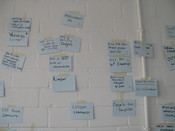Decision-Making -Tool
Life can be view as a constant series of decisions. Decision-making is a key component in how we function on a personal and professional level. Only by making rational decisions do we take charge of our lives. Just as people are different, so are their styles of decision-making. There are many approaches to decision-making, depending on the nature of the problem and the people involved in the problem. Wise decisions are decisions that are made using a specific process and there are definite advantages to using a specific process to make a decision; the most obvious advantage is the reduced level of stress we will experience. Brainstorming is one of the powerful decision-making tools that one can employ.
"Brainstorming is a tool used to stimulate and capture creative thoughts and ideas". (DeJanasz, Dowd, and Schneider, 2001, p.398) Brainstorming is an excellent way of developing many creative solutions to a problem.
It works by focusing on a problem, and then coming up with very many radical solutions to it. Brainstorming is a lateral thinking process; it helps us break out of our thinking patterns into new ways of looking at things.
Brainstorming involves quickly recording a broad list of ideas, which can then be expanded and evaluated. During a brainstorming session ideas should be generated as quickly as possible in order to develop the most creative and varied list of alternatives. (Golub, 1997, p.3) As most problems are not easily solved by the first idea that comes to mind, brainstorming is an excellent way of developing many creative solutions to a single problem. Brainstorming works well individually or within a group, but is increasingly more effective when a greater amount of people are involved. This line of reasoning follows the idea that two heads are better than one. Individual brainstorming tends to produce a wider range of ideas than with group brainstorming; there is no need to worry about other people's egos or opinions, and can therefore be more freely creative. Individual may not, however, develop ideas as effectively as individual does not have the experience of a group to help. Brainstorming in a group can be very effective as it uses the experience and creativity of all members of the group. When individual members reach their limit on an idea, another member's creativity and experience can take the idea to the next stage. Therefore, group brainstorming tends to develop ideas in more depth than individual brainstorming.
Brainstorming is a method for generating ideas. Individual, teams, and departments should use brainstorming when determining possible causes and solutions to problems, and planning out the steps of a project. However, there are several ground rules that must be considered in order to successfully generate results from brainstorming:
Gather the participants from different areas with a wide range of experience as possible.
Write down a brief description of the problem.
Use the description to get everyone's mind clear of what the problem is.
Encourage an enthusiastic attitude among participants.
Write down all the solutions that come to mind.
Do not evaluate ideas until the session moves to the evaluation phase.
Do not censor any solution, no matter how silly it sounds.
The leader should keep the participants on subject.
Evaluate the list of ideas to determine the best action to correct the problem. (Clark, 1998)
Most problems are not solved automatically by the first idea that comes to mind. A brainstorming starts with a clear question, and ends with a raw list of ideas. Good brainstorming tends to come from people who have experience exploring and developing ideas on their own, and are enjoy the experience of doing it. Following these guidelines can ensure a productive and efficient formal brainstorming session.
The simplest reason for brainstorming is to increase the volume of possible ideas. It is all about generating a bumper crop of possibilities, options, and inspirations. It also helps us to collect our ideas and information logically. Some of the examples are small business ideas, possible solutions to a difficult situation, names for products, or even ideas for a fun date. The person who has to make final decisions is benefited by brainstorming, and can take all of the ideas and notes and easily convert them into some kind of action.
Advantages and disadvantages are encountered in any type of decision-making process. Brainstorming is an effective way to generate ideas but there are certain situations in which such an overwhelming response is not appropriate. For example, when a quick decision must be made, there is not sufficient time to make effective use of this decision making tool. Also, certain decisions cannot be shared, and must be made by a sole person with authority or a personal connection. Other disadvantages of brainstorming included: some people are shy to speak out their ideas as they are afraid others might find it silly, sometimes too many ideas are put in and clashing with each other which leads to arguments, some members criticize the ideas of others which lets down the others and discourages them to participate, and the possibility that someone will get credit for another person's ideas.
Being able to generate creative ideas and get them down on paper is a valuable skill. Many people use and exploit ideas for many applications, from problem solving to decision-making. One of the reason brainstorming is a popular decision-making tool is that it brings people together into the creative process and increases the social nature of the project. All the participants feel they are contributing to what they will be working on in the future. It can be a bonding experience and, more importantly, get people thinking and communicating with each other about the topics; brainstorming is a useful decision-making tool that can bring great results.


